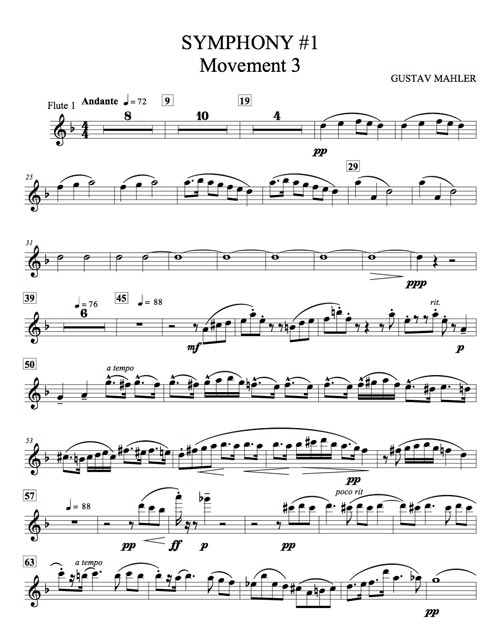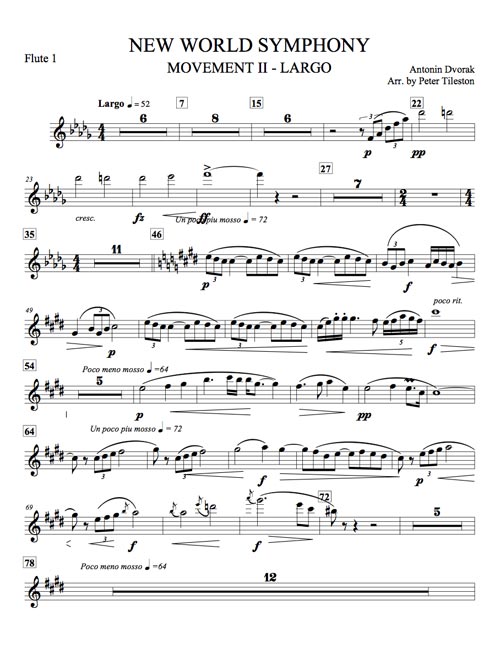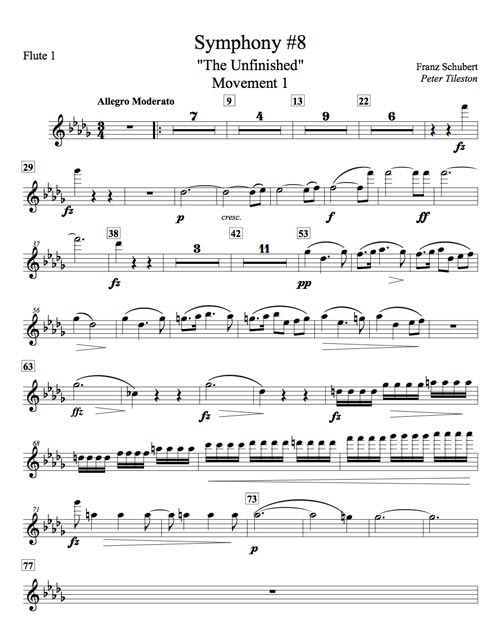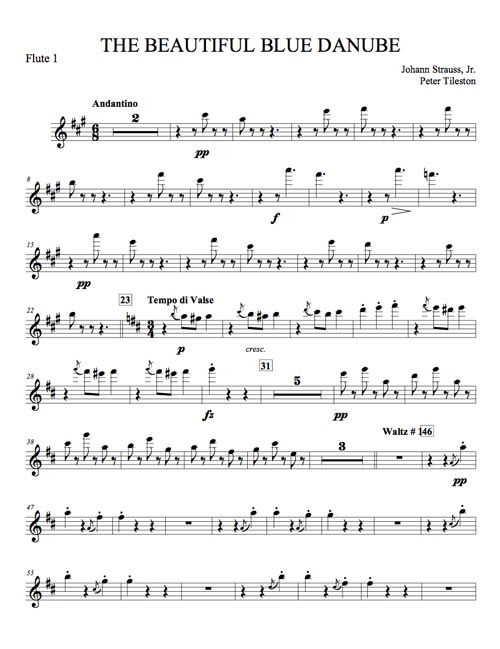Mahler - SYMPHONY No. 1 in D Major – MVT 3

Mahler - SYMPHONY No. 1 in D Major – MVT 3
SYMPHONY No. 1 in D Major – Movement 3 – Feierlich und gemassen, ohne zu schleppen
by Gustav Mahler
Score 20 Pages 8 ½ x 14 (Legal)
Instrumentation: 2 Flutes, 2 Oboes, 3 Bb Clarinets, 1 Bass Clarinet, 2 Bassoons, 1 Soprano Sax, 1 Alto Sax, 1 Tenor Sax, 1 Baritone Sax, 2 Bb Trumpets, 2 French Horns, 3 Trombones, 1 Baritone TC/Euphonium BC, 1 Tuba, 1 String Bass, Timpani, Piano/Harp, Tamtam, Bass Drum, Cymbals
The third movement acts as the slow movement of the symphony’s four movement structure. The extra-musical idea inspiring the movement is taken from The Hunter’s Funeral, an old Austrian folk story.
Mahler described the movement in a conversation with Bauer-Lechner in November 1900: "On the surface one might imagine this scenario: A funeral procession passes by our hero, and the misery, the whole distress of the world, with its cutting contrasts and horrible irony, grasps him. The funeral march of "Brother Martin" one has to imagine as being played in a dull manner by a band of very bad musicians, as they usually follow such funeral processions. The roughness, gaiety, and banality of this world then appears in the sounds of some interfering Bohemian musicians, heard at the same time as the terribly painful lamentation of the hero. It has a shocking effect in its sharp irony and inconsiderate polyphony, especially when we see the procession returning from the funeral (after the beautiful middle section), and the funeral band starts to play the usual happy tune (which pierces here to the bone)." In 1901 Mahler wrote in a letter to Bernhard Schuster: "the third movement... is heart-rending, tragic irony and is to be understood as exposition and preparation for the sudden outburst in the final movement of despair.
Mahler gives directions in the score: "Solemn and measured without dragging". After two bars, the main melodic theme forming the basis of the movement is introduced on a solo Contrabass. Mahler reproduced this melody note for note from the popular round "Bruder Martin" (Brother Martin), also known as ‘Frère Jacques’ described by August Beer as "a humorous round sung in Germany by male choirs and young men in pubs in a jocular, chanting manner." The canon section (bars 1-38) slowly builds momentum as the round is picked up by different instruments in a highly unusual order, jumping from different sections of the orchestra resulting in timbre combinations that are characteristically Mahler.
Mahler’s impressive contrapuntal technique is exhibited in the penultimate section of the movement where he interweaves three previously introduced thematic elements simultaneously on top of each other (bar 139) with the direction: plötzlich viel schneller (suddenly much faster). The despairing canon "Bruder Martin" is set against the cheerful parody melody, demonstrating the painful coexistence of tragedy and triviality in life, a theme Mahler would continue to explore in later works. The intertwining elements gradually unravel and the movement comes to a slow conclusion with alternating fourths, the unifying motive underlying the symphony, played in the lower strings.
The slow movement of Mahler’s first symphony skillfully switches from one extreme mood to another without giving the impression of a break. Mahler wrote of the movement’s ambivalent nature: "as an expression of a sometimes ironic and happy and sometimes eerie and brooding mood." The novel instrumentation, impressive counterpoint, construction of the climax, all exemplify Mahler’s ingenuity and technical prowess.
Very playable, yet demanding from a musical approach, the students really learned to love Mahler through this introduction. The piano part is the harp part and can be played by either.
When ordered, an e-file will be sent to you with both score and parts. Because of the size of the score (Legal) a professionally spiral-bound printed score can be sent to you for an additional $ 50.00 and ordered separately.
Spiral Bound Score $50.00
Listen:
Score Example:
See score example here.If you are a school order here (Purchase Order number needed)

If you are an individual order here (Invoice will be sent)

Our Latest Pieces

Dvorak
New World Symphony
New World Symphony

Mahler
Symphony No. 4
Symphony No. 4

Schubert
Unfinished Symphony
Unfinished Symphony

Strauss
Blue Danube
Blue Danube